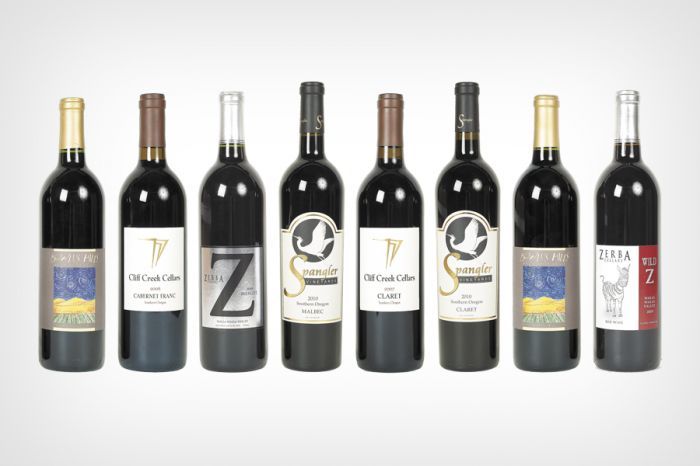Love is Blend
Bordeaux is arguably the world’s most famous wine. And, like all of France’s premium wines, its various permutations are made under strict government regulations. One is the varieties of grapes that can be used. The six allowed varietals are: Cabernet Sauvignon, Merlot, Cabernet Franc, Petit Verdot, Malbec and Carménère.
Blending is the operable word in Bordeaux. Whereas the subtle yet distinctive aroma and flavor characteristics of some varieties, prominently Pinot Noir and Riesling, are diminished, even destroyed, when blended to any extent with other varieties, quite the opposite is true with the Bordeaux family of Vitis vinifera.
Following that tried and true practice, a group of California wineries has placed emphasis on producing distinctive, Bordeaux-like blends for years. Under the fitting “Meritage” moniker, they have grown over time to number more than 250 members now operating as the Meritage Alliance. Though few of the “Meritagers” have abandoned making and marketing varietally labeled wines, they strongly espouse the value of the blending approach.
Some wineries use the term “Claret” to describe their Bordeaux blends. This term does the job just as well, having been coined by the English wine trade in the late 18th century and carried forward to become commonly used as a generic term for Bordeaux red wines. Still other producers have created their own proprietary names for their blends both red and white, which can be confusing to consumers or perhaps rewarding for those who discover the best among them.
In this month’s tasting, the panel sampled both Bordeaux blends and single varietal wines from Oregon wineries that sourced their grapes from warmer regions in Southern Oregon and in the Walla Walla Valley, bisected by the Oregon-Washington border.
Calling a bottling simply “red wine” is a perfectly valid option, though it doesn’t have quite the cachet of Claret or the heritage of Meritage. But that’s up to each winery, as is the submission of older vintages so long as they are still currently available in the marketplace.
The panel was surprised that just a handful of wineries were selected for recommendation from among all the entries submitted. We can only say this must reflect the quality brought forth from Bordeaux varieties by certain winemakers. After all, in a blind tasting the wines speak for themselves.
2009 Bowlus Hills Walla Walla Valley Cabernet Sauvignon $24 (382 cases)
The seductive aroma of ripe blackberry enhanced by a harmonious trio of leaves — celery, bay and tea — introduces delightfully dry, elegant berry and spice flavors. Beautiful balance makes this rendition of the potentate of winegrapes nothing short of irresistible. A superior wine by any standard.
2008 Cliff Creek Cellars Estate Southern Oregon Cabernet Franc $28 (340 cases)
Dark and dense, briary and tarry. No bashfulness in this big boy, whose bold flavors feature an intriguing counterpoint of sour cherry, grape jelly and pencil shavings. Firm tannins enrobe the taste experience creating a dry, yet delicious profile.
2009 Zerba Cellars Walla Walla Valley Merlot $30 (229 cases)
The nose is met by a warm, peppery aroma while the ripe, round mid-palate showcases the jammy flavors of fresh plum, dark berries and blood orange. Appealingly poised from first sip to final swallow.
2010 Spangler Southern Oregon Malbec $33 (134 cases)
Bordeaux vignerons may have given their marching orders to Malbec but Oregon could be a very different story if this fruit-filled full-flavored wine is an example. Black currant is evident throughout and tannins lend structure rather than astringency to deliver a still youthful, already tasty experience.
2007 Cliff Creek Cellars Estate Southern Oregon Claret $25 (773 cases)
This blend could have come straight out of the Medoc District in the heart of Bordeaux — Cabernet Sauvignon, 50 percent, Cabernet Franc, 30 percent, and Merlot, 20 percent. With a few years of bottle age, the three have developed complexity in both the nose — smoke, spice and rose — and the mouth — sweet herbs and a hint of mint.
2010 Spangler Southern Oregon Claret $27 (299 cases)
Dry, concentrated fruit provides the mouth-filling centerpiece of this big, balanced blend featuring the entire Bordeaux family — Cabernet Sauvignon, Merlot, Cabernet Franc, Petit Verdot, Malbec and Carménère. Dried apricot and cherry intertwine with leather and black tea as aroma and flavor profiles overlap. Resolved tannins and lingering taste complete the complex picture.
2009 Bowlus Hills Walla Walla Valley Red Blend $18 (577 cases)
Here’s a good value red wine from 2009 that combines 81 percent Bordeaux varieties — Merlot, Cabernet Franc and Cabernet Sauvignon — with a few splashes each of Sangiovese, Barbera, Tempranillo and Syrah to make an inter-European vino fino. It offers tasty touches of blueberry, white pepper and green herb on a firm tannic frame.
2009 Zerba Walla Walla Valley Wild Z Red Wine $20 (2,866 cases)
Wild Z, you’re good as can be. A floral aroma intrigues with oak vanillin, pepper, clove and a touch of talc. A meaty fullness in the mid-palate satisfies with spicy sweetness and chewy texture. Excellent balance delivers the total package via first class.
The Oregon Wine Press tasting panel has selected the following wines based on overall quality and value within their respective categories. To the best of our knowledge, they are currently available in the marketplace. Wine must be: 1) produced by an Oregon winery; 2) priced (retail) $30 or less for reds, $30 or less for Chardonnay, $30 or less for dessert and sparkling wines, and $25 or less for remaining varietals; and 3) currently available to consumers. Recommended wines were selected using a double-blind method and a 20-point ranking system for appearance, aroma, taste, balance and finish.








